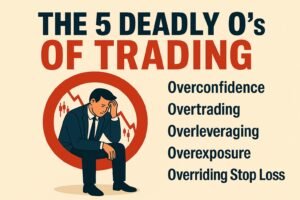
Deadly O’s of Trading:
How to Avoid Self-Sabotage and Ensure Longevity
Most trading failures are self-inflicted rather than the result of adverse market conditions. Recognizing and mitigating these five critical errors can preserve capital, foster disciplined decision-making, and improve long‑term performance.
1. Overconfidence: A Dangerous Illusion of Control
Definition:
The divergence between perceived skill and actual ability. Overconfidence manifests as an inflated assessment of one’s edge and an underestimation of risk.
Impact:
Traders who overestimate their proficiency often neglect due diligence, ignore contrary signals, and overcommit to marginal opportunities. Three psychological biases underlie this phenomenon:
– Overestimation: Belief in superior past performance or skill level without objective evidence.
– Overprecision: Excessive certainty about market predictions and strategy outcomes.
– Overplacement: The conviction of outperforming the majority of peers, despite statistical improbability.
Mitigation Strategies:
– Maintain an independent trade journal: Document entry rationales, performance metrics, and post‑trade analyses to identify recurring misjudgments.
– Conduct quantitative backtesting: Validate strategies on historical data sets to align expectations with empirical results.
– Solicit external critiques: Present trade ideas and outcomes to a peer or mentor for objective feedback.
– Adopt a pre‑trade vulnerability checklist: List potential failure scenarios and allocate contingency measures before placing any order.
2. Overtrading and Revenge Trading: The Perils of Impatience
Definition:
Excessive trading frequency or volume driven by compulsion rather than confirmed setups. Revenge trading refers specifically to rapid re‑entry following a loss, motivated by the desire to recover funds.
Impact:
Frequent, unfiltered trade execution elevates transaction costs, erodes emotional resilience, and amplifies random losses. Revenge trading further compromises objectivity, as decisions become emotion‑driven rather than analysis‑based.
Mitigation Strategies:
– Establish explicit entry criteria: Define technical or fundamental requirements that must be met before each trade.
– Implement trade quotas: Limit the number or size of positions per day or week to enforce discipline.
– Enforce cooldown periods: Require a minimum break—such as one full trading session—after any loss exceeding a predefined threshold.
– Emphasize process metrics: Track and review win rate, average risk‑reward ratio, and expectancy, prioritizing them over raw profit.
3. Overleveraging: Amplifying Risk Disproportionately
Definition:
Utilizing borrowed funds to magnify exposure, often exceeding prudent risk management thresholds.
Impact:
High leverage magnifies both profits and losses. A small adverse price movement can trigger margin calls, rapid account depletion, and impaired decision‑making due to heightened stress.
Mitigation Strategies:
– Restrict true leverage ratios: Maintain aggregate exposure below 10:1, with many professionals preferring 5:1 or lower.
– Adopt risk‑based position sizing: Allocate a fixed percentage of account equity (e.g., 1–2%) to risk per trade rather than margin requirements.
– Begin with zero or minimal leverage: Trade smaller lot sizes until consistency and confidence are established.
– Monitor leverage analytics: Correlate drawdown depths with leverage levels to refine position-sizing algorithms.
4. Overexposure: Unnoticed Correlations and Concentrations
Definition:
Concurrent positions that share underlying risk drivers—such as correlated currency pairs or sector‑specific equities—resulting in unintended concentration.
Impact:
Perceived diversification is illusory when instruments move in tandem, amplifying portfolio drawdowns instead of mitigating them.
Mitigation Strategies:
– Construct correlation matrices: Regularly analyze asset relationships across multiple timeframes to detect clustering.
– Set exposure caps: Define maximum weighting per asset class, sector, or currency family within the portfolio.
– Implement hedging tactics: Where exposure overlaps are unavoidable, use offsetting positions or derivatives to neutralize directional risks.
– Perform daily risk audits: Evaluate cumulative delta and Value-at-Risk (VaR) metrics to ensure alignment with risk tolerance.
5. Overriding Stop Losses: Undermining Risk Controls
Definition:
Disabling, widening, or delaying stop-loss orders in the expectation that adverse moves will reverse.
Impact:
Removing predefined exit points transforms a controlled risk into an open-ended loss, often culminating in catastrophic drawdowns.
Mitigation Strategies:
– Automate stop placements: Utilize OCO (One-Cancels-the-Other) or bracket orders to enforce discipline without manual intervention.
– Base stops on objective measures: Determine stop levels using Average True Range (ATR), chart patterns, or statistical volatility rather than gut instinct.
– Normalize loss acceptance: Treat stop-outs as integral data points for system refinement, not personal failures.
– Backtest stop methodologies: Compare fixed pip versus volatility‑scaled stops to optimize trade exits.
Conclusion
A professional trading approach hinges on self-awareness, disciplined execution, and rigorous risk management. By systematically addressing the five O’s—Overconfidence, Overtrading, Overleveraging, Overexposure, and Overriding Stops—traders can transform self-sabotage into self-mastery. Continuous review, process adherence, and strategic adaptability are essential to sustaining profitability in dynamic markets.
Mike Voss
